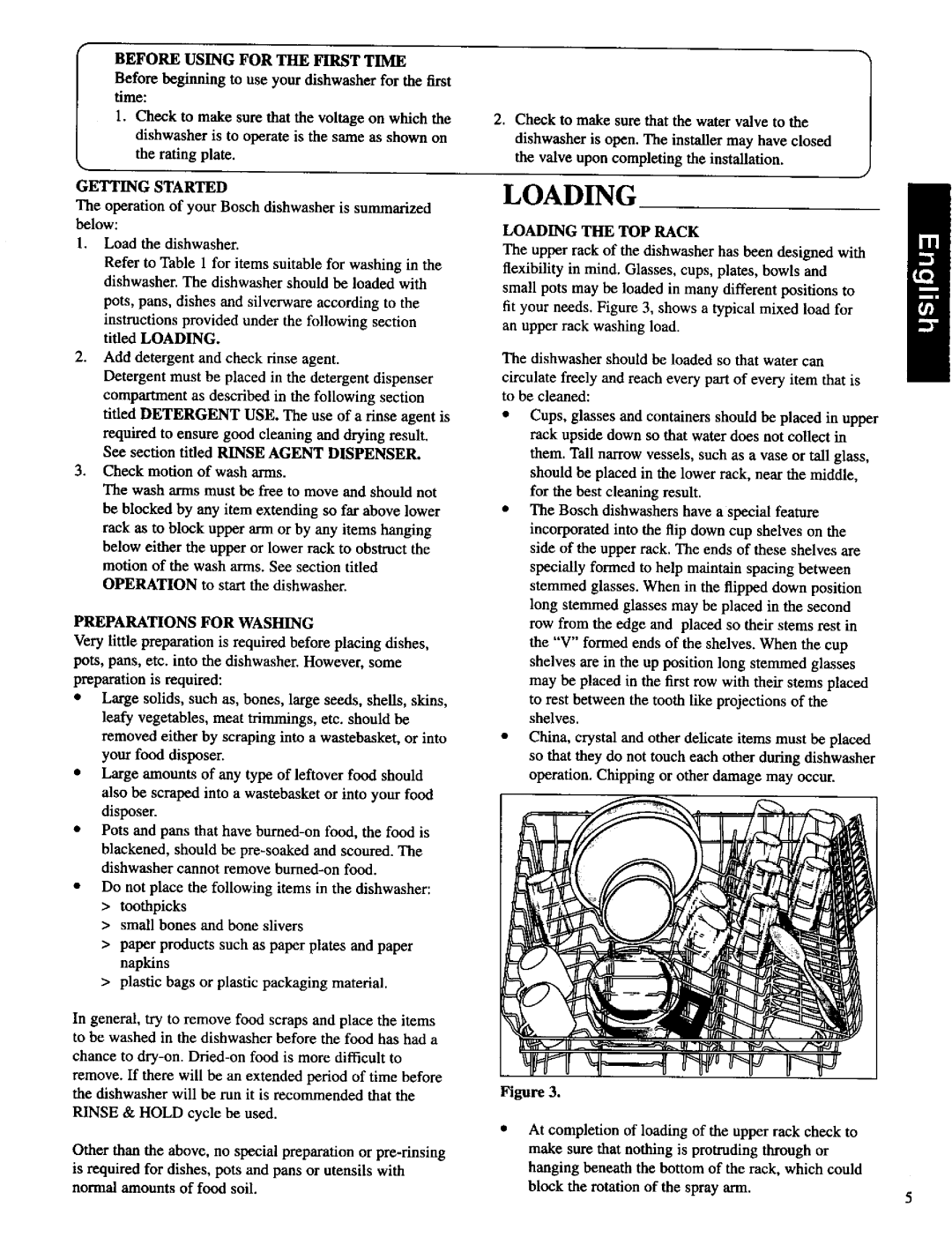
BEFORE USING FOR THE FIRST TIME
Before beginning to use your dishwasher for the first time:
1.Check to make sure that the voltage on which the dishwasher is to operate is the same as shown on the rating plate.
GETTING STARTED
The operation of your Bosch dishwasher is summarized
below:
l, Load the dishwasher.
Refer to Table I for items suitable for washing in the dishwasher. The dishwasher should be loaded with
pots, pans, dishes and silverware according to the
instructions provided under the following section tiffed LOADING.
2.Add detergent and check rinse agent.
Detergent must be placed in the detergent dispenser compartment as described in the following section titled DETERGENT USE. The use of a rinse agent is required to ensure good cleaning and drying result. See section titled RINSE AGENT DISPENSER.
3.Check motion of wash arms.
The wash arms must be free to move and should not be blocked by any item extending so far above lower rack as to block upper ann or by any items hanging below either the upper or lower rack to obstruct the motion of the wash arms. See section titled OPERATION to start the dishwasher.
PREPARATIONS FOR WASHING
Very l'tttle preparation is required before placing dishes, pots, pans, etc. into the dishwasher. However, some preparation is required:
•Large solids, such as, bones, large seeds, shells, skins, leafy vegetables, meat trimmings, etc. should be removed either by scraping into a wastebasket, or into your food disposer.
•Large amounts of any type of leftover food should also be scraped into a wastebasket or into your food disposer.
•Pots and pans that have
•Do not place the following items in the dishwasher:
>toothpicks
>small bones and bone slivers
>paper products such as paper plates and paper napkins
>plastic bags or plastic packaging material.
In general, try to remove food scraps and place the items to be washed in the dishwasher before the food has had a chance to
RINSE & HOLD cycle be used.
Other than the above, no special preparation or
is required for dishes, pots and pans or utensils with normal amounts of food soil.
2.Check to make sure that the water valve to the dishwasher is open. The installer may have closed the valve upon completing the installation.
LOADING
LOADING THE TOP RACK
The upper rack of the dishwasher has been designed with
flexibility in mind. Glasses, cups, plates, bowls and
small pots may be loaded in many different positions to fit your needs. Figure 3, shows a typical mixed load for an upper rack washing load.
The dishwasher should be loaded so that water can circulate freely and reach every part of every item that is to be cleaned:
•Cups, glasses and containers should be placed in upper rack upside down so that water does not collect in them. Tall narrow vessels, such as a vase or tallglass, should be placed in the lower rack, near the middle, for the best cleaning result.
•The Bosch dishwashers have a special feature incorporated into the flip down cup shelves on the side of the upper rack. The ends of these shelves are specially formed to help maintain spacing between stemmed glasses. When in the flipped down position long stemmed glasses may be placed in the second row from the edge and placed so their stems rest in the "V" formed ends of the shelves. When the cup shelves are in the up position long stemmed glasses may be placed in the first row with their stems placed
to rest between the tooth like projections of the shelves.
•China, crystal and other delicate items must be placed so that they do not touch each other during dishwasher operation. Chipping or other damage may occur.
_3.
At completion of loading of the upper rack check to make sure that nothing is protruding through or
hanging beneath the bottom of the rack, which could |
|
block the rotation of the spray ann. | 5 |
|
